Rod of God secret space weapon analysis: Precision-guided munition calculations show it's possible to strike almost any target on Earth from orbit with 3-4 tons of TNT explosive equivalent
 Sunday, August 23, 2015
Sunday, August 23, 2015
by Mike Adams, the Health Ranger
Tags: Rod of God, secret space weapon, Tianjin explosion
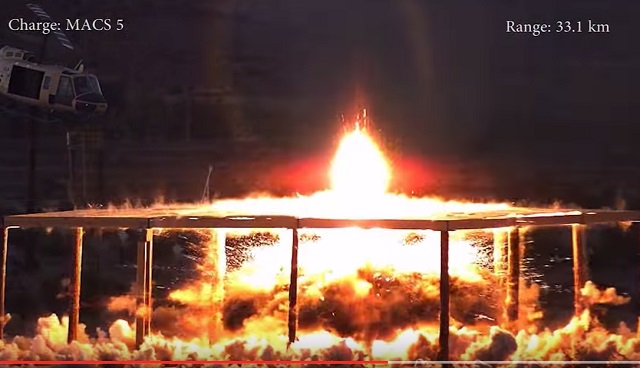
(NaturalNews) After publishing an article last week which explained that dissidents in China believe Tianjin was hit by a "Rod of God" secret space weapon from the Pentagon, I've looked more closely at the physics and telemetry control required to place such a weapon on target.
Some observers have come to the conclusion that the complexity of such a weapon system is too high for it to be a reality. They've cited several reasons for their skepticism, including the difficulty of overcoming orbital velocity, atmospheric re-entry problems, flight telemetry and so on. Some have also questioned whether the kinetic energy of such an object would be large enough to make any sort of meaningful impact on a ground-based target.
However, after analyzing the capabilities already found in today's precision-guided munitions -- such as Raytheon's Excalibur guided artillery projectile, I've come to the conclusion that today's weapons technology is more than sufficient to build and deploy a functioning "Rod of God" orbital kinetic weapon platform.
The following photo shows the Raytheon precision-guided artillery projectile striking a target within about 2 meters after being fired from 33km away:
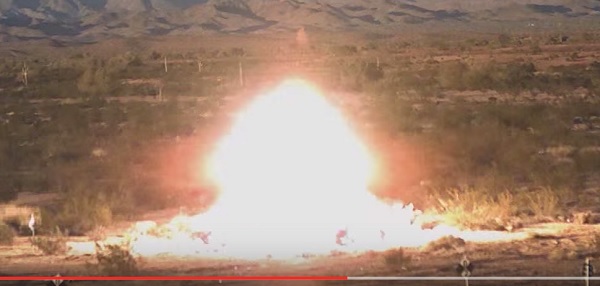
Furthermore, I've shown some estimated math, below, that indicates how a "Rod from God" space-based weapon could deliver 3-4 tons of TNT explosive equivalent to any land-based target on Earth. This is precisely in the range that was reported for the first explosion at Tianjin.
Guided munitions have a wide range when dropped from high orbit
The primary objection to the "Rod of God" weapons system says that such a system can essentially only drop weapons onto targets that are directly beneath the orbiting platform.However, this objection doesn't pan out. In reality, laser-guided bombs (LGBs) and other precision munitions have remarkable lateral maneuverability even though they possess no thrust or rockets themselves. By simply altering small control surfaces, they can "glide" laterally onto designated targets that are far from being "directly beneath" the launch platform.
For example, this Raytheon video show a precision-guided artillery shell striking numerous targeted within 1.6 meters, even after flying 33km or more through unknown winds after being fired from an artillery cannon.
Some observers have stated that guided munitions ("rods") could not survive re-entry into the atmosphere. However, guided munitions already exist that are ridiculously hardened, including the "BLU-122-5000 pounds, with internal components able to survive 10,000 Gs of lateral acceleration and still function at the bunker level," reports MilitaryAerospace.com.
Keep in mind, too, that precision-guided artillery shells obviously survive being shot out of an artillery cannon, subjecting them to extreme heat, acceleration and friction forces.
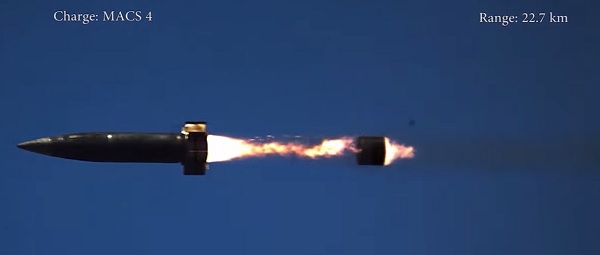
Orbital velocity is not a limitation
Some people who object to the idea of Rod of God space weapons incorrectly state that the orbital space platform would be placed at too high an orbital velocity relative to the Earth, requiring kinetic weapons to need excessive "braking" in the atmosphere to bleed off lateral orbital speeds so that they could drop vertically onto intended targets.This objection incorrectly assumes that the Rod of God platform is in low Earth orbit, requiring orbital speeds of around 8km/s relative to the planet to stay in orbit. The assumption is false, however. The farther the orbit from the planet, the smaller the relative orbital speed differential. For example, if you place a satellite into geostationary orbit (35,786 km), its relative orbital velocity to the planet's ground speed is exactly ZERO (which is the whole point of a geostationary orbit).
Interestingly, if you place a Rod of God weapons platform into a semi-synchronous orbit at a distance of 20,350km from the planet, the platform will orbit the planet every 12 hours while maintaining very slow velocity relative to the movement of the land below. A semi-synchronous orbit (or a quad-synchronous orbit with a 6 hour orbital period) would allow the Rod of God platform to (nearly) cross over the continents twice per 24 hour period, all while maintaining an orbital velocity of just 3.86km/s (a velocity that's even lower, relative to the ground, if the orbit is placed in alignment with the Earth's rotation). From this orbital altitude, a rod could be dropped onto the planet in a matter of just a few hours (the actual orbital decay time depends on orbital velocity, angle of trajectory and other factors).
These orbital velocities, by the way, only speak to the relative speed of the launch platform compared to the movement of the Earth's land mass. They don't address the more important question of the vertical "drop" velocity of the rods. Next, I examine the vertical drop and the kinetic energy delivered on target.
Vertical drop and kinetic energy
As you ponder this issue, remember that in space, every planet rests at the bottom of a so-called "gravity well." Ground zero is the bottom of the well, and high orbit is high above the well. The higher you are (i.e. the greater your distance from the planet), the greater the kinetic energy you have "stored" in the object you're dropping onto the planet. In space, in other words, the "high ground" is high orbit.Tactically speaking, you want to maximize the energy delivered to the intended target by the Rod of God weapon, and this means you want to maximize the velocity at which the rod strikes the ground (without burning up your rod in the atmosphere). Because energy = one-half the mass times velocity squared, the velocity achieved here is far more important than the mass itself.
Essentially, you want to "drop" a rod from a very high orbit in order to maximize its velocity and energy. Because the acceleration of gravity is 9.8 meters per second per second (on Earth, anyway), the higher you place the orbital platform the higher the velocity of the object when it strikes the atmosphere.
Naturally, there is a limit to the speed a given object can maintain in free-fall through atmosphere. This is called "terminal velocity," and the more aerodynamic your object (i.e. the less drag it has), the higher the terminal velocity in atmosphere. If your object is moving too quickly, it can be "burned up" in the atmosphere (obliterated by frictional forces). So there is a practical limit to the velocity your object can survive.
A large, high-density rod with a tapered leading and trailing edge would slice through the atmosphere with very little drag, maintaining a relatively high velocity until impact, thereby carrying the maximum kinetic energy to the target. Tactically speaking, you would want to drop these rods from the highest altitude possible without exceeding their survivable speed limit upon striking atmosphere.
I don't personally have the materials science background to know what sort of materials and densities are capable of achieving this. Such data, if it exists, would obviously be classified top secret, which means Hillary Clinton probably emailed it to somebody from her unsecured mail server.
While I can't give you exact answers here -- and I welcome a more accurate analysis on this from rocket scientists who want to chime in -- I can take an educated guess on what's possible with today's exotic materials:
According to Apollo by the Numbers, most of the later Apollo capsules -- with men living inside them -- re-entered the atmosphere at velocities of around 36,000 feet per second, or over 10 km/s. This is both lateral speed and vertical speed, by the way, with the vast majority of this velocity appearing in the lateral (orbital) vector, not the vertical vector.
Note that the Apollo capsules are not aerodynamic by any stretch of the imagination. They are shaped to brake in the atmosphere, bleeding off velocity in exchange for heat generation by molecular friction impacting the capsule's heat shield. If you are designing an unmanned kinetic weapon, you don't need to bleed off speed. In fact, you want to maintain maximum vertical speed through the atmosphere so that the maximum energy can be delivered on target.
If the Apollo capsule can withstand 10 km/s re-entry speed at the upper layers of Earth's atmosphere (where the molecular density is thin), we can reasonably guess that an exotic rod-shaped kinetic weapon made entirely of high-density materials and shaped with a ridiculously low drag coefficient could likely enter at four times that velocity, or 40 km/s.
Slicing through atmosphere will, of course, cause dramatic friction on the object, creating heat and a braking effect. What's the terminal velocity of such an object? We have some simulation data to help answer this question.
According to this scientific simulation paper from Defence Science Journal (Defence Science Journal, Vol. 64, No. 6, November 2014, pp. 502-508, DOI : 10.14429/dsj.64.8110), the terminal velocity of a supersonic artillery shell is roughly 1km/s in low-Earth atmosphere.
A higher density "rod" weapon designed with exotic materials and dropped from high Earth orbit would obviously arrive on target at some velocity higher than 1km/s, but we don't know how much higher. Conservatively, let's estimate four times the velocity of an artillery shell, or 4km/s. In case you're curious, this is roughly Mach 12.
Can anything really move through the atmosphere at Mach 12?
According to MissileThreat.com, a cruise missile under development right now will propel itself at Mach 7:
BrahMos-II is a hypersonic cruise missile currently under joint development by India's Defence Research and Development Organisation (DRDO) and Russia's NPO Mashinostroeyenia. It is the second of the BrahMos series of cruise missiles. The BrahMos-II is expected to have a range of 290 kilometres (180 mi) and a speed of Mach 7 (8,575 km/h; 5,328 mph; 2.3820 km/s). During the cruise stage of flight the missile will be propelled by a scramjet airbreathing jet engine. It is expected to be ready for testing by 2017.
Back to the Rod of God, the greater question here, however, is whether the rod can survive the atmospheric re-entry speed that's necessary to result in it striking the ground at 4km/s.
In other words, if V1 is the velocity of entry into the atmosphere, then the equation we are pondering is:
4km/s = V1 - B1
V1 = velocity upon entering the atmosphere
B1 = velocity reduction caused by braking in the atmosphere
The real question here is: Can a "Rod from God" weapon survive V1? Or will it "burn up" from friction with the atmosphere? We can't know the answer to this, and the Pentagon isn't telling. But we can guess that the space weapons industry is at least two decades ahead of what they're telling the public.
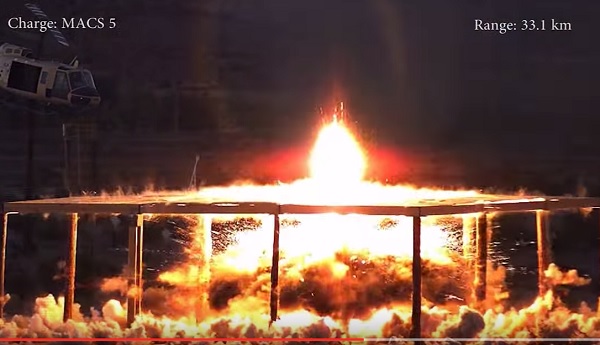
Delivering 4 tons of TNT equivalent kinetic energy onto the target
Here's the math of the kinetic energy delivered to the target:At 4km/s upon impact, a mass of, say, 2000kg (a two-ton rod) would deliver:
Kinetic Energy (Joules) = 0.5 x 2000 x (4000 ^ 2)
Answer = 16,000,000,000 Joules
or 16 billion Joules.
or stated as 16 x 10^9.
The atomic bomb dropped on Hiroshima unleashed approximately 64 TJ (terajoules), or approximately 4,000 times the kinetic energy of our Rod of God weapon.
Because one ton of TNT is equivalent to 4.184 × 10^9 joule (J), if our exotic rod weapon unleashes 16 x 10^9, then it delivers the energy of four tons of TNT onto the target.
Is four tons of TNT useful as a tactical weapon? If you can deliver it on target from space, it certainly is!
First Tianjin explosion was reported as 3 tons of TNT equivalent
Interestingly, this is right in line with the reports from Tianjin, China, where two explosions took place. It was widely reported in the media that the first explosion represented about 3 tons of TNT, setting off a secondary explosion that reached about 21 tons of TNT.From CNBC.com:
The second blast was equal to about 21 tons of TNT exploding, while the first was the equivalent of about 3 tons of TNT, according to numerous reports.
In other words, a "Rod of God" weapon could have conceivably achieved a 3-ton TNT equivalent, and if delivered directly on target, it could have easily set off the secondary chemical explosion.
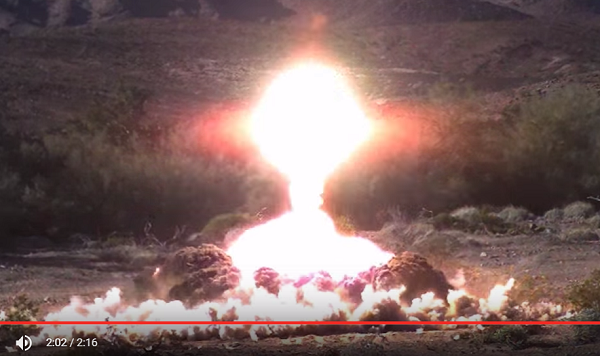
How could the Rod of God reach targets that aren't directly underneath it?
Those who are assuming the Rod of God orbital weapons platform must drop the rods STRAIGHT down are making a tremendous error. No such limitation exists in space. There's no reason why the launch platform can't rotate before launching the rod on a desired trajectory, and there's no reason why a rod can't have a small, detachable thruster motor that works in space (yet detaches before atmospheric re-entry).The initial trajectory angle of the Rod of God upon launch could allow it to reach almost any land-based target on the planet below. A relatively small thrust charge ignited after launch could drive the trajectory in any direction in space. This is especially the case if the launch platform is orbiting far from the planet, allowing more time for launch vectors to alter the final arrival destination below.
Once the rod reaches atmosphere, small changes in control surfaces could easily glide the rod to within 2 meters of any intended target on impact, using the exact same technology that already exists in precision munitions on Earth (tiny adjustable surfaces near the tail).
In all, these three innovations would allow a space-based Rod of God weapon to hit ANY target on planet Earth:
1) The ability to rotate the platform to launch the rods at varying angles relative to the planet.
2) The ability to add thrust to the rod itself through a small, one-time rocket motor.
3) The ability to guide the rod using existing precision munitions technology that alters control surfaces in the atmosphere to deliver munitions on target.
Notably, this does not mean that the Rod of God platform can hit any target AT ANY TIME. It cannot. This is the limitation of the system. It must wait for the precise launch window of opportunity, which only appears once every few hours, depending on the placement of the orbit, the direction of the orbit relative to the Earth's spin, and so on. However, within a given timeframe (let's say from 6 - 24 hours), the Rod of God platform would be able to strike any target on Earth, and that's more than sufficient for the Pentagon's strategic bombardment requirements.
The other limitation is that from the time of launch, the Rod of God might take many hours before arriving on impact. This "time of flight" can be easily calculated if you know the orbital altitude, orbital velocity, launch velocity, launch vector and booster thrust acceleration and duration. Depending on these factors, this time of flight could reasonably be anywhere from 2 to 24 hours, I'd guess.
Importantly, note that nearly all the important guidance takes place before the rod enters the atmosphere. Once in the atmosphere, it can only achieve minor lateral movement for fine adjustments. I'm guessing that the lateral movement range through the atmosphere is no more than 10 miles (the atmosphere is about 60 miles thick, roughly speaking). So once the rod drops into the atmosphere, it needs to be within 10 miles of the target in terms of lateral position (or headed on a path that takes it to within that window).
That's why most of the positioning of the rod must happen in orbit, and this is why the launch angle and rocket boost after launch are so important to it striking its intended target on land.
Conclusion: The Rod of God concept seems feasible, but we can't know the Pentagon's secrets to confirm it
Here, I've shown that the kinetic energy delivered by a "Rod of God" weapon could reasonably match the first explosion observed in TianJin. I've also explained why the orbital velocity and atmospheric re-entry objections are not show-stoppers.The biggest question, in my opinion, is whether a rod can survive the extremely high forces of friction with the atmosphere as it plummets toward its target at very high velocities (Mach 12, for example). This is primarily a materials question, and there's no way we can know for sure what sort of exotic materials the Pentagon has developed.
One thing we can know with 100% certainty, however, is that the Pentagon doesn't publicly disclose its space weapons secrets. If it does possess a Rod of God space weapon, it sure isn't going to announce it to anyone. Especially given how amazingly useful such a weapon would be for the stealth striking of enemy targets anywhere on the planet.
Remember: if this weapon exists, it puts a weapon on target while producing no apparent launch signature. This is, in every way, a stealth weapon that no one can stop once it's launched. You wouldn't even be able to see it approaching, either. Dropping through the atmosphere at Mach 12, it would strike the target like a bolt from the heavens, causing enormous destruction and leaving quite a large crater in the ground, just like we saw at Tianjin.
Rod of God at FETCH.news
Get independent news alerts on natural cures, food lab tests, cannabis medicine, science, robotics, drones, privacy and more.
 About the author:Mike Adams (aka the "Health Ranger") is a best selling author (#1 best selling science book on Amazon.com) and a globally recognized scientific researcher in clean foods. He serves as the founding editor of NaturalNews.com and the lab science director of an internationally accredited (ISO 17025) analytical laboratory known as CWC Labs. There, he was awarded a Certificate of Excellence for achieving extremely high accuracy in the analysis of toxic elements in unknown water samples using ICP-MS instrumentation. Adams is also highly proficient in running liquid chromatography, ion chromatography and mass spectrometry time-of-flight analytical instrumentation.
About the author:Mike Adams (aka the "Health Ranger") is a best selling author (#1 best selling science book on Amazon.com) and a globally recognized scientific researcher in clean foods. He serves as the founding editor of NaturalNews.com and the lab science director of an internationally accredited (ISO 17025) analytical laboratory known as CWC Labs. There, he was awarded a Certificate of Excellence for achieving extremely high accuracy in the analysis of toxic elements in unknown water samples using ICP-MS instrumentation. Adams is also highly proficient in running liquid chromatography, ion chromatography and mass spectrometry time-of-flight analytical instrumentation.
Adams is a person of color whose ancestors include Africans and Native American Indians. He's also of Native American heritage, which he credits as inspiring his "Health Ranger" passion for protecting life and nature against the destruction caused by chemicals, heavy metals and other forms of pollution.
Adams is the founder and publisher of the open source science journal Natural Science Journal, the author of numerous peer-reviewed science papers published by the journal, and the author of the world's first book that published ICP-MS heavy metals analysis results for foods, dietary supplements, pet food, spices and fast food. The book is entitled Food Forensics and is published by BenBella Books.
In his laboratory research, Adams has made numerous food safety breakthroughs such as revealing rice protein products imported from Asia to be contaminated with toxic heavy metals like lead, cadmium and tungsten. Adams was the first food science researcher to document high levels of tungsten in superfoods. He also discovered over 11 ppm lead in imported mangosteen powder, and led an industry-wide voluntary agreement to limit heavy metals in rice protein products.
In addition to his lab work, Adams is also the (non-paid) executive director of the non-profit Consumer Wellness Center (CWC), an organization that redirects 100% of its donations receipts to grant programs that teach children and women how to grow their own food or vastly improve their nutrition. Through the non-profit CWC, Adams also launched Nutrition Rescue, a program that donates essential vitamins to people in need. Click here to see some of the CWC success stories.
With a background in science and software technology, Adams is the original founder of the email newsletter technology company known as Arial Software. Using his technical experience combined with his love for natural health, Adams developed and deployed the content management system currently driving NaturalNews.com. He also engineered the high-level statistical algorithms that power SCIENCE.naturalnews.com, a massive research resource featuring over 10 million scientific studies.
Adams is well known for his incredibly popular consumer activism video blowing the lid on fake blueberries used throughout the food supply. He has also exposed "strange fibers" found in Chicken McNuggets, fake academic credentials of so-called health "gurus," dangerous "detox" products imported as battery acid and sold for oral consumption, fake acai berry scams, the California raw milk raids, the vaccine research fraud revealed by industry whistleblowers and many other topics.
Adams has also helped defend the rights of home gardeners and protect the medical freedom rights of parents. Adams is widely recognized to have made a remarkable global impact on issues like GMOs, vaccines, nutrition therapies, human consciousness.
In addition to his activism, Adams is an accomplished musician who has released over a dozen popular songs covering a variety of activism topics.
Click here to read a more detailed bio on Mike Adams, the Health Ranger, at HealthRanger.com.
Take Action: Support Natural News by linking to this article from your website
Permalink to this article:
Embed article link: (copy HTML code below):
Reprinting this article:
Non-commercial use OK, cite NaturalNews.com with clickable link.
Follow Natural News on Facebook, Twitter, Google Plus, and Pinterest
- The REAL FAKE NEWS exposed: '97% of scientists agree on climate change' is an engineered hoax... here's what the media never told you
- Four natural remedies for a quick and easy gut detox
- Heal gum disease in a week or less
- Apricot Seeds Kill Cancer Cells without Side Effects
- Parents now being thrown in jail in America for homeschooling their children
- Milk myths and facts: Some food for thought
- Cancer is not a Disease - It's a Survival Mechanism (Book Excerpt)
- 'Rollie pollies' remove heavy metals from soil, stabilizing growing conditions, protecting groundwater
- FDA finally admits that asthma drugs can actually cause serious asthma attacks
- Cleanse your system of parasites naturally
- Sea cucumber extract kills 95 percent of breast cancer cells and shrinks lung tumors
- Poultry industry, like the beef industry, is steeped in evil practices
- Chinese bought division of IBM that manufactures computing servers for U.S. Navy Aegis cruisers
- Six amazing foods for cleansing your colon naturally
- Study shows body fat is a safe haven for cancer cells; reducing excess fat can help beat the disease
- The eight best home remedies and holistic treatments to relieve tinnitus and ringing in the ears
- Monsanto found guilty of chemical poisoning in landmark case
- Six little-known natural remedies for tinnitus
- The REAL FAKE NEWS exposed: '97% of scientists agree on climate change' is an engineered hoax... here's what the media never told you
- Sea cucumber extract kills 95 percent of breast cancer cells and shrinks lung tumors
- Untested vaccines causing new wave of polio-like paralysis across India
- Four natural remedies for a quick and easy gut detox
- Six little-known natural remedies for tinnitus
- Beat cancer with 35% hydrogen peroxide
- Polish study says vaccines have no historical benefits, continue to cause neurological damage
- Apricot Seeds Kill Cancer Cells without Side Effects
- How to heal cavities naturally
- Dr. David Gorski named in medical conspiracy allegations complaint filed with Karmanos Cancer Center and Michigan Attorney General
- Discover a common yard weed that's proven to kill cancer cells
- TIN FOIL HAT: Washington Post claims Natural News is controlled by the Russian government
- Poultry industry, like the beef industry, is steeped in evil practices
- The truth about tanning beds: They boost vitamin D production
- Handling Pet Treats Can Cause Human Ills (press release)
- Hurricane warnings wildly exaggerated by NOAA to terrorize Americans about climate change
- The hidden dangers of caffeine: How coffee causes exhaustion, fatigue and addiction
- Heal gum disease in a week or less
- The REAL FAKE NEWS exposed: '97% of scientists agree on climate change' is an engineered hoax... here's what the media never told you
- Six little-known natural remedies for tinnitus
- High-dose vitamin C injections shown to annihilate cancer
- Supplements to detox the body from vaccinations
- Four proven natural remedies for chronic inflammation
- Beat cancer with 35% hydrogen peroxide
- Apricot Seeds Kill Cancer Cells without Side Effects
- Cannabis kicks Lyme disease to the curb
- Foods that detox heavy metals - with tonic recipe
- Olive oil antioxidant naturally kills all cancer cells tested within an hour
- Four bitter herbs heal the liver, gall bladder, and other ailments
- Curcumin causes colon cancer cells to self-destruct
- The best and worst forms of magnesium to take as a supplement
- Top 10 inexpensive food items that can PREVENT nearly every disease and disorder known to mankind
- Foods, herbs, and supplements that kill cancer - safer and more effective than drugs
- Untested vaccines causing new wave of polio-like paralysis across India
- Vitamin B-12 warning: Avoid cyanocobalamin, take only methylcobalamin
- Sea cucumber extract kills 95 percent of breast cancer cells and shrinks lung tumors
- EPA advisor admits the agency is funneling billions to climate groups ahead of Trump’s return to White House
- Newly released JFK files reveal Pentagon's role in creating Lyme disease and covid in the same lab
- Eleven days before Iran bombed Tel Aviv, my microscope revealed haunting images of EXACTLY what would happen
- Morphic resonance “remote viewing” reveals iconic Middle East images of stealth bombers, a falcon and a one-horned ram
- Mike Adams releases country western hit single: Goin’ Back in Time is Comin’ Home
- DECENTRALIZED SPIRITUALITY and the true teachings of Christ: Overcoming the censorship, threats and lies of organized religion to truly know God and the Universal Christ
- HEALTH SECRETS: How to Instantly Block MSG Toxicity Using Natural Substances (and the secret of Methylene Blue)
- Global leaders unite to clamp down on “misinformation” with UN-backed Cascais Declaration
- The Health Ranger releases “Vaccine Zombie” song and music video, using AI-animated zombies for the music video
- I Want My Bailout Money – new song released by Mike Adams
- BOMBSHELL: Internal Pfizer documents exposed and reveal at least 16 PERCENT of their mRNA vaccine "adverse events" are REPRODUCTIVE DISORDERS
- BOMBSHELL: DNA testing kits are a SCAM to develop ethnic-specific bioweapons
- BOMBSHELL: Covid-19 mRNA nanoparticles EMIT LIGHT SIGNALS that communicate MAC addresses used for self-assembly inside the blood vessels
- Amazing microscopy photos reveal how freezing crystals attempt to mimic electronic structures they are touching
- RFK Jr. clears key hurdle: Sen. Susan Collins backs controversial HHS nominee, signaling a new era for health policy
- The Coming Gold Revaluation: Strategic Financial Realignment in an Era of Dollar Collapse
- The AI Data Center Wars Have Begun… Farms, Water and Electricity is Stripped from Humans to Power the Machines
- Urgent Wake-Up Call: The Coming AI Robot Wars and the Great Human Unity
Science News & Studies
Medicine News and Information
Food News & Studies
Health News & Studies
Herbs News & Information
Pollution News & Studies
Cancer News & Studies
Climate News & Studies
Survival News & Information
Gear News & Information
News covering technology, stocks, hackers, and more



"Big Tech and mainstream media are constantly trying to silence the independent voices that dare to bring you the truth about toxic food ingredients, dangerous medications and the failed, fraudulent science of the profit-driven medical establishment.
Email is one of the best ways to make sure you stay informed, without the censorship of the tech giants (Google, Apple, Facebook, Twitter, YouTube, etc.). Stay informed and you'll even likely learn information that may help save your own life."
–The Health Ranger, Mike Adams























